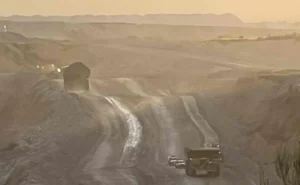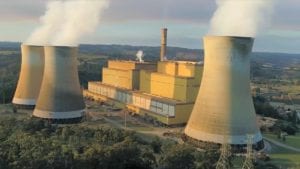
The Land Court recommendation against expansion of New Acland Coal (NAC) open cut mine has exposed the ongoing complaints by neighbours, about dust, noise, vibrations and lighting spills from the existing mine. Could this be the turning point for improvement or even reform of health and environmental assessments in Queensland?
It is important that all governments and politicians read the revelations in the judgement. The Judge said:
If I were to reduce this matter to its simplest terms, one may wonder how it can be that the NAC revised Stage 3 project has been subject to so much controversy, let alone almost 100 hearing days before this Court, almost 2,000 exhibits containing many tens of thousands of pages of material, and well in excess of 2,000 pages of submissions. [19]
In short, there is a significant mining operation, by a large publicly listed Australian owned mining company, which has been operating for over 15 years and proposes to continue operations for more than a decade into the future by way of a further expansion. [24]
To use a card playing analogy, it would seem to be a ‘lay down misere’ that the Stage 3 expansion should proceed. This position is only strengthened when one takes into account that the Stage 3 project has both the approval of the State Coordinator-General, as well as that of the Commonwealth Minister for the Environment. [25]
To read the submissions of the objectors in this case, one could be forgiven for thinking that I was dealing with an entirely different case to the circumstances set out above. [28]
The objectors’ submissions paint a picture of a mine out of place in the Acland rural agricultural setting. They speak of generation after generation of farmers undertaking agricultural, dairying and grazing activities on lush land with plentiful supplies of rain and groundwater. They talk of the town of Acland with pride, revelling in its winning of Tidy Town’s awards, including being the first state-wide winner of the award in 1989, and reflect on the area’s strong ties with war veterans, recognised through the war memorial located in Acland. [29]
They speak with sad voices at the loss of the vast majority of the town of Acland through the actions of NAC by purchasing, then removing almost all of Acland’s homes and buildings, and complain that the Stage 1 and Stage 2 operations of New Acland have made life a misery for those who live in close proximity to the mine because of what they say to be excesses in dust, noise, vibrations, lighting spill etcetera emanating from the mine. They fear for the future of their groundwater bore supplies. [30]
The objectors complain that their complaints about the mine have been virtually ignored by the mine and government regulators. They say, collectively, that enough is enough, and that Stage 3 should not proceed [31]
Evidence was given by many landholders and others from the community regarding the effect of the existing mine on their health. It is now evident that over many years they may have been exposed to preventable heart and lung diseases because of inadequate air quality and noise monitoring control, and lack of a safety zone between operations and habitations.
Health Impact Assessment of a development is an essential part of the Environmental Impact Assessment process to inform government decisions. The cost of failure to protect and promote health falls on governments, the community and individual members of the public. These costs are unlikely to be borne by a proponent. Ensuring that such costs are not incurred by non-beneficiaries is both equitable and good economics.
Will governance in Queensland respond to this condemnation of its unsatisfactory response to complaints by improving its assessment processes and responses to neighbours complaints? Essentially the same evidence exposed in the case was given in a letter to Doctors for the Environment Australia (DEA) in 2011, yet the judgement showed little has been done to alleviate the plight of the community over six years.
DEA was so concerned by the information and subsequent contact with the community representatives in 2011 that we wrote to several Queensland Ministers and, recognising that they would do little, we also wrote to Minister Burke here highlighting the effects of the coal mine on locals from noise, air pollution, water pollution and on their mental health and we provided expert evidence on air quality.
These were precisely the concerns highlighted by the judge in his judgement six years later.
We also detailed these concerns in 2013 and 2014 submissions on the Environmental Impact Statement here and here.
In relation to Air pollution the Judge said:
“I have no doubt that [residents] have been greatly inconvenienced and impacted by dust produced by the mine and given their evidence, it is quite possible EA limits with respect to dust and particulate matter have been exceeded”. [587]
“Evidence from nearby residents …indicate that dust has been an ongoing issue for them since NAC began its open cut coal mining operations some 15 years ago. In fact there has been over 100 complaints recorded on NAC’s complaint’s register regarding dust and another 30 or so dust related complaints to EHP.” [580]
And in relation to noise:
“The objectors…..have provided the literal ‘truck load’ of evidence and material detailing what they say to be unacceptable levels of noise generated by NAC’s operation of Stages 1 and 2” [721].
“My independent, considered view on what I have before me is consistent with the evidence given by the objectors that they have actually been treated very poorly by both NAC and the statutory party”. [721]
“This demonstrates what I can only call the folly of the regime under the current Environmental Authority
And for water the Judge said:
The principles of intergenerational equity are breached in at least one regard by the proposed revised Stage 3, with the potential for groundwater impacts to adversely affect landholders in the vicinity of the mine for hundreds of years to come
In conclusion, over six years this company had trampled on the complaints and health concerns of the local residents.
Their concerns were ignored by the instruments of government which were supposed to protect them.
The assessment of the project from the state government which went to the Federal minister for sign-off had their purulent impacts sanitised by its departments
The implications of this judgement are many.
The judgment shows the injustice perpetrated on Queensland citizens by government and developers driving what they see as necessary projects.
In this regard DEA has assessed many developments in Queensland and believes that the environmental and health assessments are flawed leading to projects being approved and operating despite unsatisfactory impacts.
Evidence to this effect was presented in a submission on the Enquiry into Queensland Government Administration.
Indeed the evidence of flawed health processes is there for all to see with the development of black lung disease in coal miners.
The ability of the government to effectively assess and decide upon proposed coal mines in Queensland must be also be questioned.
Presently the Courts offer the only hope for impartial judgement when state and federal governments act to support approval.
The federal government may have an argument to interfere with green tape in Queensland, not because it takes too long and is too costly, but because of state incompetence. More green tape in the form of better assessment processes are needed.
Surely state influence on these processes has to be removed. There has to be an independent arbiter that provides a well-researched decision that can be accepted by community as beneficial to all parties, and by developers because it is unlikely to be contested.
The present system is a farce and a danger to health. Will there ever be a federal government with the vision and ability to establish a National EPA that could discourage inappropriate actions of companies seeking favour from eminent hospitals?
Dr David Shearman AM FRACP is Hon. Secretary of Doctors for the Environment Australia and Emeritus Professor of Medicine University of Adelaide










